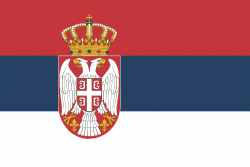Ljig (Opština Ljig)
 |
 |
It is surrounded by Mount Rajac and Mount Rudnik.
The recorded history of the Ljig settlement itself begins in 1911, when a railroad was built between Lajkovac and Gornji Milanovac. The area, however, has a long history. The Dići church was founded by Serbian nobleman Vlgdrag, who was buried here in 1327. The ruins of the medieval Vavedenje Monastery include impressive sarcophagi dating from the 15th century, believed to belong to the Serbian despots Stefan Branković and Đurađ Branković. According to legend, Djuradj's wife, Jerina, was buried there as well.
An early reference to "Ljig" can be found in the 17th century records of Evliya Çelebi, which describe "LIGmehri" (the Ljig River) rising from Kara Dag in the village Baht (today's Ba) and flowing into the Kolubara River near Valjevo. No settlement in the area was known to the Austrians when they occupied Serbia from 1717 to 1739. By 1818, however, the nearby settlement Gukosi had grown to 50 homes.
A railway station was built in 1917 near the present-day center of Ljig. This lower area under the Gukoši hill includes a small settlement with a municipal court, school, inn, two stores, two textile mills, three tailors and several houses, and when still part of Gukoši had been referred to as the area "on the Ljig River."
During World War I, the Battle of Kolubara was fought nearby, making this area significant in history of Serbia and of war, and in military science. A monument memorializing the battle has been erected on Rajac Mountain.
Ljig separated from Gukoši in 1922, and by 1930 a school, health center and church were built. Prior to that time, Ljig residents had worshipped in Moravci.
Map - Ljig (Opština Ljig)
Map
Country - Serbia
 |
 |
| Flag of Serbia | |
Continuously inhabited since the Paleolithic Age, the territory of modern-day Serbia faced Slavic migrations in the 6th century, establishing several regional states in the early Middle Ages at times recognised as tributaries to the Byzantine, Frankish and Hungarian kingdoms. The Serbian Kingdom obtained recognition by the Holy See and Constantinople in 1217, reaching its territorial apex in 1346 as the Serbian Empire. By the mid-16th century, the Ottomans annexed the entirety of modern-day Serbia; their rule was at times interrupted by the Habsburg Empire, which began expanding towards Central Serbia from the end of the 17th century while maintaining a foothold in Vojvodina. In the early 19th century, the Serbian Revolution established the nation-state as the region's first constitutional monarchy, which subsequently expanded its territory. Following casualties in World War I, and the subsequent unification of the former Habsburg crownland of Vojvodina with Serbia, the country co-founded Yugoslavia with other South Slavic nations, which would exist in various political formations until the Yugoslav Wars of the 1990s. During the breakup of Yugoslavia, Serbia formed a union with Montenegro, which was peacefully dissolved in 2006, restoring Serbia's independence as a sovereign state for the first time since 1918. In 2008, representatives of the Assembly of Kosovo unilaterally declared independence, with mixed responses from the international community while Serbia continues to claim it as part of its own sovereign territory.
Currency / Language
| ISO | Currency | Symbol | Significant figures |
|---|---|---|---|
| RSD | Serbian dinar | дин or din. | 2 |
| ISO | Language |
|---|---|
| BS | Bosnian language |
| HU | Hungarian language |
| SR | Serbian language |
















